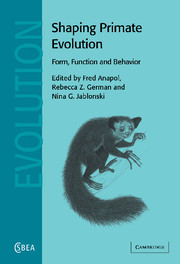Book contents
- Frontmatter
- Contents
- List of contributors
- Preface: shaping primate evolution
- 1 Charles Oxnard: an appreciation
- Part I Craniofacial form and variation
- Part II Organ structure, function, and behavior
- 6 Fiber architecture, muscle function, and behavior: gluteal and hamstring muscles of semiterrestrial and arboreal guenons
- 7 Comparative fiber-type composition and size in the antigravity muscles of primate limbs
- 8 On the nature of morphology: selected canonical variates analyses of the hominoid hindtarsus and their interpretation
- 9 Plant mechanics and primate dental adaptations: an overview
- 10 Convergent evolution in brain “shape” and locomotion in primates
- Part III In vivo organismal verification of functional models
- Part IV Theoretical models in evolutionary morphology
- Part V Primate diversity and evolution
- Index
- References
8 - On the nature of morphology: selected canonical variates analyses of the hominoid hindtarsus and their interpretation
Published online by Cambridge University Press: 10 August 2009
- Frontmatter
- Contents
- List of contributors
- Preface: shaping primate evolution
- 1 Charles Oxnard: an appreciation
- Part I Craniofacial form and variation
- Part II Organ structure, function, and behavior
- 6 Fiber architecture, muscle function, and behavior: gluteal and hamstring muscles of semiterrestrial and arboreal guenons
- 7 Comparative fiber-type composition and size in the antigravity muscles of primate limbs
- 8 On the nature of morphology: selected canonical variates analyses of the hominoid hindtarsus and their interpretation
- 9 Plant mechanics and primate dental adaptations: an overview
- 10 Convergent evolution in brain “shape” and locomotion in primates
- Part III In vivo organismal verification of functional models
- Part IV Theoretical models in evolutionary morphology
- Part V Primate diversity and evolution
- Index
- References
Summary
Introduction
Large-scale distinguishing features of the larger tarsal bones between different species of hominoids may readily be discerned with the naked eye. For example the talus of gorillas is visually quite different from that of humans: characteristic differences in the detail of the body, trochlea, and head may easily be identified. Likewise the calcanei of orangutans may be differentiated unambiguously from those of humans, or indeed from other apes. A visual distinction between the smaller tarsal elements, such as cuneiform bones, in differing hominoid groups is not so obvious, but nevertheless possible.
However, many far more subtle and complex morphological features and patterns do exist, both within species as have been identified in humans, or between related species such as between hominoid groups. Such patterns of morphological variation are only identifiable with the aid of quantification and multivariate statistical techniques (e.g., Day and Wood, 1968; Lisowski et al., 1974, 1976; Steele, 1976; Rhoads and Trinkaus, 1977; Pickering, 1986; Kidd, 1995, 2001; Kidd et al., 1996; Kidd and Oxnard, 1997, 2002). Appropriate multivariate techniques, applied correctly and with prudence, provide the investigator with a far richer investigative methodology than simple univariate statistics. The choice of multivariate technique will depend largely upon the nature of the question being asked. If, as is the case in this series of studies, interest lies in differences in tarsal morphology between related groups and species, canonical variates analysis (CVA) is the most appropriate technique as it maximizes differences between those groups (Albrecht, 1980, 1992; Reyment et al., 1984).
- Type
- Chapter
- Information
- Shaping Primate EvolutionForm, Function, and Behavior, pp. 162 - 192Publisher: Cambridge University PressPrint publication year: 2004



